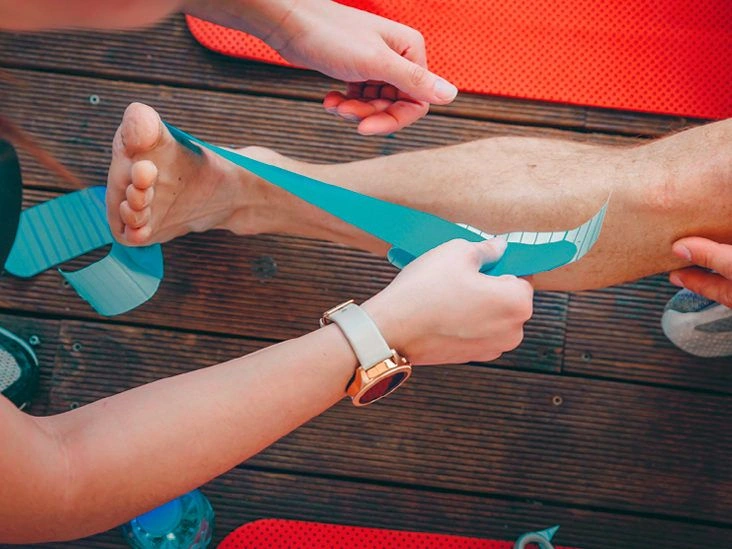Shin splints, medically known as medial tibial stress syndrome, arise when the muscles, tendons, and bone tissue surrounding the shinbones become irritated. You may feel soreness or aching where the muscles attach to the bone along the front or inner border of the tibia. The discomfort can present as dull, sharp, or throbbing pain.
This condition commonly develops from repetitive motion, overuse, and a lack of variety in your exercise regimen. Athletes who participate in high-impact sports involving running and jumping — particularly on hard surfaces — are at greater risk.
Individuals with flat feet or rigid arches are more susceptible to shin splints. Resuming exercise after a hiatus or ramping up the intensity or frequency of workouts can also contribute to their development.
Kinesiology therapeutic (KT) tape may be useful for both preventing and treating shin splints. KT tape can help stabilize the muscles around the shin and promote improved blood flow. By providing gentle compression, the tape may enhance circulation and alleviate pain. It’s often used alongside other recovery methods.

Taping instructions
To get the best results, apply the tape using correct technique. Follow the steps carefully and consult a professional if you need assistance.
There are several taping approaches. Here’s a YouTube video from John Gibbons to show how this is done:
When applying tape, make sure it’s firm but not overly tight or restrictive. To help the adhesive stick, shave the area to be taped — this also makes removal more comfortable. If you’re prone to skin reactions, perform a patch test on the skin first.
Other taping methods for shin support include:
Anterior
- Set the foot at a 45-degree angle.
- Begin at the front of the ankle.
- Wrap the tape around the outside of the ankle and up toward the inner calf at a 45-degree angle.
- Then pull the tape across to the inside of the leg.
- Repeat this 3 to 4 times.
- Anchor the tape at both the top and bottom.
Posterior
- Set the foot at a 45-degree angle.
- Fix the tape a few inches below the inner ankle.
- Pull the tape up along the inside of the leg.
- Place another strip closer to the heel.
- Pull the tape up at an angle curving toward the calf.
- Apply another strip above the heel.
- Pull this strip up along the back of the leg.
- Apply another strip above the heel.
- Pull it across to the top of the foot and curve it to run along the front of the shin.
- Place another strip about an inch below the previous one.
- Again, pull it across to the top of the foot and curve it along the front of the shin.
- Secure the tape at both ends.
Lateral
- Set the foot at a 45-degree angle.
- Start at the inside front of the ankle and wrap the tape around the back of the ankle.
- Pull the tape upward toward the outer calf and shin at a 45-degree angle.
- Repeat this 4 times.
- Anchor the tape at the top and bottom.
To support arches
- Place your foot at a 45-degree angle.
- Lay a 1/2-inch piece of felt along the longitudinal arch of the foot.
- Use prewrap to hold the felt in place.
- Apply strips of tape around the foot.
- While taping, gently lift the arch.
- Place strips at the ball of the foot.
- Begin at the top of the foot and wrap outward under the foot, then up and across the arch.
- Repeat this 3 to 4 times.
Does it work?
Studies indicate that KT tape may help improve function in people with shin splints. A small 2018 study reported that KT tape reduced pain and increased hop distance in individuals with hyperpronation, and the taping method outperformed standard orthotics in that study.
Kinesiology tape can enhance circulation and promote muscle relaxation in the affected region, which helps ease pain and discomfort. It may also support the area and decrease pressure and tension on the muscles.
Applying tape can limit unwanted motion, reducing the likelihood of moving in ways that cause injury. Keep in mind that rest is the cornerstone of shin splint recovery. Reduce activity to allow muscles time to heal, and choose low-impact options if you don’t want to stop exercising entirely.
Other tips
To prevent issues and recurrence, it’s best to address shin splints as soon as symptoms appear. These tips can help speed recovery:
- Rest. Take as much downtime as possible. When you resume activity, progress slowly. Gradually boost workout intensity and duration, and reduce or pause activity if symptoms return.
- Pick the right shoes. Wear well-cushioned footwear that offers support and shock absorption. Replace running shoes every 3 to 6 months or after about 300 to 500 miles.
- Do exercises and stretches. Targeted stretches and strengthening exercises promote healing and help prevent re-injury. Because shin splints may be linked to wider imbalances, include routines that address the whole body to enhance strength, flexibility, and range of motion.
- Self-massage. Use your hands, a foam roller, or a massage stick to gently work the lower leg and foot muscles. This relieves tension, boosts circulation, and enhances mobility. Avoid direct pressure on the shinbone.
- Run on softer surfaces. Choose grass, a track, or a treadmill to lessen impact on your shins. Avoid hard pavement, tile, and steep hills, which can worsen symptoms.
- Hot and cold therapy. Use a sauna, steam room, or hot bath to ease muscle tightness. To reduce pain and swelling, apply ice for 10 to 15 minutes after activity.
- Do low-impact activities. Balance intense workouts with cross-training in gentler modalities during recovery, such as swimming, cycling, or using an elliptical.
Products to consider
KT tape is available at pharmacies, sporting goods stores, and online.
Compression gear can support the lower legs and lessen stress in the area. Consider compression sleeves, socks, or bandages.
If you have flat feet or persistent shin splints, orthotics may help. Shoe inserts reduce lower leg strain and help align and stabilize the feet and ankles. Options include custom and over-the-counter orthotics.
Where to buy
You can purchase the items above online:
When to consult a professional
Address shin splints promptly to avoid long-term complications. Depending on how severe and persistent the condition is, full recovery can take several weeks to months.
See your doctor if you’ve tried remedies and your shin splints aren’t improving, or if they’re chronic. Also seek medical attention if the shins are swollen, red, or warm to the touch — these signs could indicate another underlying issue.
Your physician may direct you to a physical therapist who can help you develop healthier movement patterns and prevent overuse. A therapist can also advise on proper footwear.
The bottom line
With the right strategy, shin splints can be managed and treated. It’s crucial to address the root causes rather than just masking symptoms. This may involve strengthening muscles and correcting alignment problems.
Give your body the rest it needs, and when you return to activity, progress gradually while watching for symptom recurrence.
KT tape can be a helpful tool to support and reduce stress on the lower legs during exercise. For optimal outcomes, pair taping with other recovery approaches.
Consult a doctor or physical therapist for tailored advice on using KT tape to prevent and treat shin splints. They can rule out other conditions, assess imbalances, and ensure you’re moving with proper form.


















Leave a Reply
You must be logged in to post a comment.